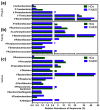Mechanistic Insights into the Link between Gut Dysbiosis and Major Depression: An Extensive Review
- PMID: 35456041
- PMCID: PMC9030021
- DOI: 10.3390/cells11081362
Mechanistic Insights into the Link between Gut Dysbiosis and Major Depression: An Extensive Review
Abstract
Depression is a highly common mental disorder, which is often multifactorial with sex, genetic, environmental, and/or psychological causes. Recent advancements in biomedical research have demonstrated a clear correlation between gut dysbiosis (GD) or gut microbial dysbiosis and the development of anxiety or depressive behaviors. The gut microbiome communicates with the brain through the neural, immune, and metabolic pathways, either directly (via vagal nerves) or indirectly (via gut- and microbial-derived metabolites as well as gut hormones and endocrine peptides, including peptide YY, pancreatic polypeptide, neuropeptide Y, cholecystokinin, corticotropin-releasing factor, glucagon-like peptide, oxytocin, and ghrelin). Maintaining healthy gut microbiota (GM) is now being recognized as important for brain health through the use of probiotics, prebiotics, synbiotics, fecal microbial transplantation (FMT), etc. A few approaches exert antidepressant effects via restoring GM and hypothalamus-pituitary-adrenal (HPA) axis functions. In this review, we have summarized the etiopathogenic link between gut dysbiosis and depression with preclinical and clinical evidence. In addition, we have collated information on the recent therapies and supplements, such as probiotics, prebiotics, short-chain fatty acids, and vitamin B12, omega-3 fatty acids, etc., which target the gut-brain axis (GBA) for the effective management of depressive behavior and anxiety.
Keywords: depression; gut dysbiosis; gut microbiota; gut–brain axis; hypothalamus–pituitary–adrenal axis; major depressive disorder; serotonin; short-chain fatty acids.
Conflict of interest statement
The authors declare that they have no conflict of interest.
Figures



References
-
- Cao C., Liu M., Qu S., Huang R., Qi M., Zhu Z., Zheng J., Chen Z., Wang Z., Han Z., et al. Chinese Medicine Formula Kai-Xin-San Ameliorates Depression-like Behaviours in Chronic Unpredictable Mild Stressed Mice by Regulating Gut Microbiota-Inflammation-Stress System. J. Ethnopharmacol. 2020;261:113055. doi: 10.1016/j.jep.2020.113055. - DOI - PubMed
-
- Ferrari A.J., Charlson F.J., Norman R.E., Patten S.B., Freedman G., Murray C.J., Vos T., Whiteford H.A. Burden of Depressive Disorders by Country, Sex, Age, and Year: Findings from the Global Burden of Disease Study 2010. PLoS Med. 2013;10:e1001547. doi: 10.1371/journal.pmed.1001547. - DOI - PMC - PubMed
-
- Little A. Treatment-Resistant Depression. Am. Fam. Physician. 2009;80:167–172. - PubMed
Publication types
MeSH terms
Substances
Grants and funding
LinkOut - more resources
Full Text Sources
Medical

